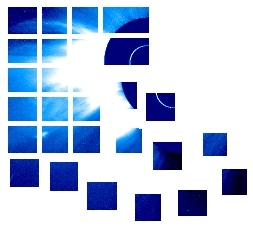In some ways, sound is the best method for getting a 'big picture' of an item. Think of a large body of water. With your eyes close, you can tell the gentle lapping of a lake from the burble of a brook, the flow of a river, or the periodic crashing waves of an ocean.

Our sensor data is MIDI, akin to player piano rolls or sheet music. We map sensor data to musical scales. So the data says an equivalent piano key was pressed at a given tone with a given amount of force, akin to a data frequency and magnitude. What plays that tone is up to the musician on the ground.
Here's a set of samples that simulate what we expect. Each sample snippet is four seconds of MIDI sensor data. On the ground, we map each of 3 sensors to a typical 'space' MIDI instrument:
Here is a 30 second .wav file sample set (2.5MB in size).
Sample 1) Thermal sensor, baseline arbitrarily set at an F#, changes on timescales of tens of minutes
Sample 2) Magnetic sensor, baseline at D, moves to D# in simulated 'field change'
Sample 3) Light sensor, assuming a random spin slightly faster than one rotation/second
After each plays individually, we put them together.
Sample 4) Now we play them simultaneously, the way the satellite would.
Then we start playing around a bit.
Sample 5) What if we remap the MIDI data for "Temperature" to a new instrument-- a drum track?
This last sample is a case of 'false mapping', where we obscure the actual data-- a flat, unchanging state of affairs-- by giving it false rhythm. It's artistically interesting, but I would call it an 'overzealous mapping'.
Sample 6) And now we remap the Magnetic field sensor to a new instrument, something space-y?
We've now remapped 2 of the 3 data feeds to a different instrument. The data hasn't changed, just our choice of musical instrument that plays it back.
Sample 7) The resulting new mix.
And in the hands of a _talented_ musician, imagine what we'll enjoy! I will be releasing the Project Calliope data as royalty-free tracks, remixable and reusable, gratis.
And now to close on a random bit. Recently I was interviewed by NPR and by Wired, and then I found this very interesting 'translation salad' site that explains it best. Near as I can tell, they took the original Wired article, ran it through a foreign language translator, then translated it back to English, all to avoid plagerism. So instead of plagerism, we end up with incoherency:
Once deployed, they can put out enough energy to be picked up on the belligerent by the hand-held pledge airwave receiver. [from Tubesat Gerber]
Just pledge me belligerent, but I'm getting this instrument to space!
Alex
Alex "Sandy" Antunes, Ph.D.
http://ProjectCalliope.com, 'Music from Space', Launching Spring 2011
Details every Tuesday here at The Satellite Diaries , Science every friday at the Daytime Astronomer





Comments